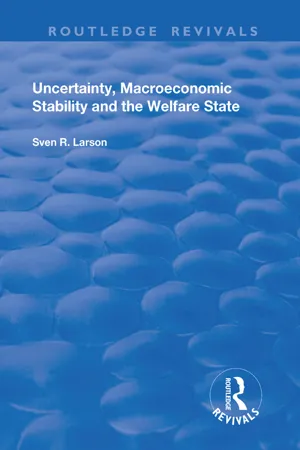Economics
Supply and Demand
Supply and demand is a fundamental concept in economics that describes the relationship between the quantity of a good or service that producers are willing to supply and the quantity that consumers are willing to buy. It is represented graphically as the intersection of the supply and demand curves, which determines the equilibrium price and quantity in a market. When supply and demand are in balance, it leads to an efficient allocation of resources.
Written by Perlego with AI-assistance
Related key terms
9 Key excerpts on "Supply and Demand"
- eBook - ePub
Health Economics For Nurses
Intro Guide
- Stephen Morris(Author)
- 2014(Publication Date)
- Routledge(Publisher)
2 Basic theory of economics: demand, supply and the market solutionIn this chapter we examine the basic aspects of economic theory which lay the foundation for the analysis of the following chapters. The discussion concentrates on the development and explanation of the basic tools of economics: demand, supply and markets, and how they may be used in response to the problem of scarcity. The discussion is general in nature, and is not specifically related to health care or nursing at this stage. These issues will be examined in following chapters.Summary1. The basic problem which economics attempts to address is that of scarce resources. Because of scarcity, all economic decisions necessarily involve a choice in terms of what goods to produce, how to produce them and who shall receive them.2. One way of addressing these issues is to use the notion of a market, in which resource allocation decisions are determined by the independent decisions of consumers and producers, and signals in the form of prices are used to allocate resources.3. There are two components of a market: demand and supply.4. The quantity of a good that consumers are willing and able to buy in a specific time period is called the demand for a good, and is influenced by many variables including the price of the good, income, the prices of other goods and tastes.5. There is, in general, an inverse relationship between the price of a good and the quantity demanded of that good. 6. The demand curve may be derived using the Law of Diminishing Marginal Utility and the assumption that consumers wish to maximise their utility. 7. By supply we mean the quantity of a good that producers will wish to offer for sale at a particular price per time period. 8. The quantity supplied of a good is also influenced by a number of variables, such as the price of the good, the prices of other goods and the costs of production. 9. There is, in general, a positive relationship between the price of a good and the quantity supplied of that good. - eBook - ePub
- Rob Dransfield(Author)
- 2013(Publication Date)
- Routledge(Publisher)
Market forces – changes in demand and supply. The relative strength of demand and supply determines the market prices of goods.Market prices act as signals to producers about the strength of demand for the products they supply. Rising prices act as an incentive for producers to produce more of certain types of goods. In contrast, falling prices will encourage consumers to buy more goods as they become relatively cheaper. Gaining a clear understanding of the four laws of demand and supply will enable you to have a good grasp of how the market works.Key Term3.4 The construction of demand and supply curves Demand and supply curvesChanges in demand and shifts in demand – economists distinguish between a ‘change’ in ‘demand’ (where the whole demand curve changes its position, e.g. as a result of a change in tastes or incomes), and ‘changes’ in ‘quantity demanded’ (i.e. movements along a given demand curve). Changes in quantity demanded result from a change in the price of the good whose demand is being examined.A demand curve is used by economists to illustrate the relationship between price and quantity demanded. It shows demand and changes in quantity demanded. It is useful for business organizations trying to predict the effect of different prices on demand for their products. It helps them to decide how much of a good to make in order to meet quantity demanded.Common sense and personal experience explain the shape of the demand curve. The curve slopes down from left to right because more people can afford to buy goods at lower rather than at higher prices. Existing purchasers of a good will be tempted to buy more of a good at a lower price because they have to give up less of their income to make the purchase. Table 3.4 and Figure 3.1 - eBook - ePub
Economics for Investment Decision Makers
Micro, Macro, and International Economics
- Christopher D. Piros, Jerald E. Pinto(Authors)
- 2013(Publication Date)
- Wiley(Publisher)
CHAPTER 1
DEMAND AND SUPPLY ANALYSIS: INTRODUCTION
Richard V. Eastin Gary L. Arbogast, CFALEARNING OUTCOMES
After completing this chapter, you will be able to do the following:- Distinguish among types of markets.
- Explain the principles of demand and supply.
- Describe causes of shifts in and movements along demand and supply curves.
- Describe the process of aggregating demand and supply curves, the concept of equilibrium, and mechanisms by which markets achieve equilibrium.
- Distinguish between stable and unstable equilibria and identify instances of such equilibria.
- Calculate and interpret individual and aggregate demand and inverse demand and supply functions, and interpret individual and aggregate demand and supply curves.
- Calculate and interpret the amount of excess demand or excess supply associated with a nonequilibrium price.
- Describe the types of auctions and calculate the winning price(s) of an auction.
- Calculate and interpret consumer surplus, producer surplus, and total surplus.
- Analyze the effects of government regulation and intervention on demand and supply.
- Forecast the effect of the introduction and the removal of a market interference (e.g., a price floor or ceiling) on price and quantity.
- Calculate and interpret price, income, and cross-price elasticities of demand, and describe factors that affect each measure.
1. INTRODUCTION
In a general sense, economics is the study of production, distribution, and consumption and can be divided into two broad areas of study: macroeconomics and microeconomics. Macroeconomics deals with aggregate economic quantities, such as national output and national income. Macroeconomics has its roots in microeconomics - eBook - ePub
- Tom Craig, David Campbell(Authors)
- 2012(Publication Date)
- Routledge(Publisher)
So far in this chapter, we have looked at the demand side (the quantity that would be demanded over a range of prices) and the supply side (the quantity that would be supplied over a range of prices). The problem is that we do not yet know what the actual price of a good or service will be. Both the demand and supply curves represent a number of possible price–quantity situations, but we do not know at what price the product will actually sell.The Equilibrium Point
By comparing a product’s Supply and Demand curves on the same graph, we can see that there is one price that both parties (producers and buyers) ‘agree’ on. This is the point at which both the suppliers and the consumers agree. The noted Cambridge economist Alfred Marshall described the Supply and Demand curves as two blades of a pair of scissors. Neither blade on its own is enough to ‘cut a price’. They must both be present and known before the price can be determined.We can see how this works by looking again at the Supply and Demand curves for potatoes at the fruit and vegetable shop we considered earlier (Figures 17.4 and 17.11). If we look at these two curves together, we can see that at a price of 20 pennies and a quantity of 700 pounds per week, the curves intersect. This intersection is called the equilibrium point (Figure 17.14 ).Figure 17.14 The equilibrium point, potatoes at Mr Marrow's shop (per week).Disequilibriums
The term equilibrium is used in this context for a very deliberate reason. The reason for this is that whenever the equilibrium is disturbed, the market price will always tend to return to this point.If the Supply and Demand curves remain approximately in position over a long period of time, the equilibrium price and quantity are likely to similarly remain in a stable position. A condition called disequilibrium can occur when for one reason or another, a price or quantity situation exists which is away from the intersection point of the two curves. The ways in which this can happen are shown in Figure 17.15. - eBook - ePub
Media Economics
Applying Economics to New and Traditional Media
- Colin Hoskins, Stuart M. McFadyen, Adam Finn(Authors)
- 2004(Publication Date)
- SAGE Publications, Inc(Publisher)
Individual demand is how much one person or household wishes to buy. Market demand is the total amount all people in the market wish to purchase and is the sum of the demands by individuals. In this chapter, we will concentrate on market demand. Demand is not just a want; it concerns what will actually be bought at different prices and hence is a wish backed by willingness and ability to pay. Buying a product has an opportunity cost, sacrificing consumption of another good that could be bought instead. Thus wanting or even “needing” a good does not constitute demand unless this sacrifice of the next best alternative is acceptable. The market demand for a given good or service will typically vary with the product’s own price, the prices of demand-related products, the level of per capita (per person) income, the number of potential buyers in the market, expected future prices, and the tastes of consumers. In this chapter, we will examine the effect of (the product’s) own price on the quantity demanded of the good, assuming for now that the values of these other determinants of demand are given and unchanged. 2.1.1 How Does the Quantity Demanded Vary With Price? When we refer to a price change in this and other chapters, we are referring to a change in the price of a specific good relative to other goods. Thus an absolute increase in the price of newspapers by 5% is not a price change in this sense if the prices of all other goods increased by 5% also. Other things being equal, the higher the price, the smaller the quantity demanded. Equivalently, the lower the price, the greater the quantity demanded. This is known as the Law of Demand. The major reason for the Law of Demand is the Substitution Effect resulting from the change in relative prices. An increase in the price of a good will make it a less attractive purchase relative to substitute goods whose prices are unchanged. Some people will thus switch to purchasing one of the substitutes. All goods have substitutes - eBook - ePub
- Tony Aspromourgos(Author)
- 2008(Publication Date)
- Routledge(Publisher)
WN: 428). Notice the contrast: plenty for the people, sufficiency for the State.3.3 Market prices, supply dynamics and the role of demand
3.3.1 Role of supply versus demand
While Smith nowhere uses the phrase ‘Supply and Demand’ or ‘demand and supply’ when he articulates the determination of market prices, he uses language which easily, but dangerously, can be translated into those terms.30 That phrase, later to become so commonplace, is indeed somewhat suggestive of symmetric forces, which is precisely how later marginalist theory sought to conceptualize Supply and Demand, in terms of a kind of equilibrium balancing of opposing forces. Smith’s characteristic expression—‘supply the demand’ and similar phrases—rather is suggestive of a certain asymmetry: of supply adjusting to demand. This in turn flows from his notion of D* the fixed point, (D*, pn), the centre of gravity, with Q adjustment doing the work of balancing the market. That the given quantity D* presupposes pn, serves to confirm that Smith treats pnas independent of Q, at least in relation to just the quantity variations associated with correction of ‘market imbalances’. If that were not so, D* could not be given independent of quantity supplied. Smith’s characteristic treatment of pmibehaviour under competitive conditions is a description of the dynamic motion of actual prices in situations of market imbalance: the dynamics of deviation and convergence of pmiwith respect to pn - eBook - ePub
Potatoes
Production, Marketing, And Programs For Developing Countries
- Douglas Horton(Author)
- 2019(Publication Date)
- CRC Press(Publisher)
4Supply, demand, and marketingMost potato growers derive cash income from the crop. Where potatoes are a high-priced food, farmers usually market their harvest and use the income to purchase less expensive staples for their own needs. Even where potatoes are cheap enough for farm families to consume as a staple food, farmers usually sell part of their crop.Potato prices in most countries are set by market forces rather than by government fiat. Changes in price levels strongly influence both the decisions and the welfare of potato producers and consumers. Thus marketing is not only important but controversial. Producers usually feel the prices they receive for their potatoes are too low, whereas consumers feel the prices they pay are too high. Moreover, it is often believed that low producer prices, high consumer prices, and price instability are due to inefficient or exploitive marketing practices. This is sometimes, but not always, the case.Supply and Demand
The branch of economics known as price analysis provides a useful framework for understanding how prices are determined and for pinpointing marketing problems. The concepts of Supply and Demand are at the heart of price analysis. A supply curve indicates the quantities that would be offered for sale or supplied by producers at different price levels; a demand curve indicates the quantities that would be demanded by consumers at different prices (Fig. 7 ). When Supply and Demand curves are plotted on the same scale, their point of intersection marks the equilibrium price at which the amount offered for sale is equal to the amount that will be purchased.Figure 7 . Supply and Demand curves, showing the market equilibrium price (P) and quantity (Q).The principles of Supply and Demand apply in both market economies and centrally planned economies. When governments fix prices, signs that the government-mandated price is below the market equilibrium level are shortages, rationing, and long lines of would-be customers standing outside food stores. Stockpiled surpluses, on the other hand, indicate that prices are above the equilibrium level. - eBook - ePub
- (Author)
- 2018(Publication Date)
- Agenda Publishing(Publisher)
This corresponds to the move along the original demand curve from A to B occasioned by the new position of the supply curve in the first of the two diagrams in Figure 4.1, such that the quantity demanded increases from Q 0 to Q 1 whilst the market price falls from P 0 to P 1. By the same token, they do not need to have plotted a leftward shift in the demand curve onto the standard two-dimensional representational space to be aware that if they work in an industry that is subject to this sort of outsourcing then jobs like theirs are likely to become less plentiful and also pay rather less. This corresponds to the move along the original supply curve from A to B occasioned by the new position of the demand curve in the second of the two diagrams in Figure 4.1, such that the number of jobs fall from Q 0 to Q 1 whilst the market wage rate also falls from P 0 to P 1. The language of demand and supply is too well known for these effects to have to be spelt out explicitly. This level of familiarity is also an important component of the jump between the market concept and treating “the market” as if it had a mind of its own to determine the results that it sought to impose. If “the market” is seen as having demand and supply curves that adjust automatically to changes in external economic conditions, then its judgement is not to be second-guessed and its will is simply to be accommodated. Figure 4.1: Shifting Supply and Demand curves respectively It is important, however, not to make the mistake of thinking that for as long as people have wanted to write about the economy they have been able to rely on the language of demand and supply to do so. This is not a language that is somehow inherent in nature and simply needed the introduction of market institutions for its outline to spontaneously come into view. Like all other human languages it is an invented tradition designed to reflect a reality whose features are defined by social convention - Sven R Larson(Author)
- 2019(Publication Date)
- Routledge(Publisher)
A price offer from seller to buyer consists only of a money price, but also of a commitment to keep that nominal value unchanged for a certain period of time. This period is the number of market days, τ, during which the seller will offer a given product at one and the same price. When a buyer purchases from the seller, she tacitly accepts the offer when prices are displayed by stickers or otherwise publicly announced with no personal relation between buyer and seller. If the agreement is written and obviously legally enforceable, then we refer to it as a contract. The contract does, of course, define the money price but it is also an agreement on the time horizon of the price offer. Based on the money price and the time horizon stated in a contract — and the confidence they enclose — consumers then decide on what quantity to demand.Demand thereby signals production needs to the supply side, a side of the market that has been left outside our analysis so far. As stated, the demand function simply responds to a given price offer from the seller, agreeing to the offer with a demand of whatever amount she feels inclined to buy (given the present state of confidence). But how does the seller receive a signal on how much to produce? Does the seller agree to make any explicit commitment to any quantity at the given price?Our model is based on Keynes’s effective demand principle, which in effect says that demand creates its own supply; whatever volume is demanded will also be produced. This mechanism presupposes intertemporal signalling from buyer to seller, and that signal in turn presupposes an accepted price signal from seller to buyer. Thus, containing our sticky price preference — or time utility preference — the principle of effective demand implies a flat supply function: sellers are ready to put on the market whatever volume is demanded under a standing money price offer.While this order of appearance of price and quantity decisions is necessary to bring macroeconomic uncertainty down to controllable proportions (Davidson 1986) it is also evident that this order constitutes a problem to producers. It simply means that they have to size their production capacity in advance of putting their product on the market. This in turn means that:
Learn about this page
Index pages curate the most relevant extracts from our library of academic textbooks. They’ve been created using an in-house natural language model (NLM), each adding context and meaning to key research topics.








